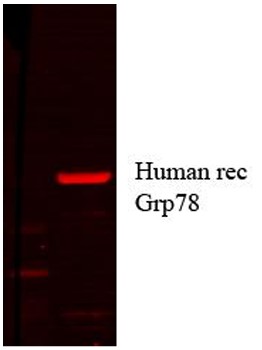Anti-GRP78 Antibody (11134)
$346.00
| Host | Quantity | Applications | Species Reactivity | Data Sheet | |
|---|---|---|---|---|---|
| Mouse | 100ug | WB,ELISA | Human, Mouse, Rat, Bovine, Hamster, Rabbit, Monkey, Xenopus, Fungal (Cryphonectria Parasitica) |  |
SKU: 11134
Categories: Antibody Products, Heat Shock and Stress Protein Antibodies, Products
Overview
Product Name Anti-GRP78 Antibody (11134)
Description Anti-Grp78 Mouse Monoclonal Antibody
Target GRP78
Species Reactivity Human, Mouse, Rat, Bovine, Hamster, Rabbit, Monkey, Xenopus, Fungal (Cryphonectria Parasitica)
Applications WB,ELISA
Host Mouse
Clonality Monoclonal
Clone ID 1H11-1H7
Isotype IgG2b
Immunogen His-tagged human GRP78 (accession no. NP_001156906.1)
Properties
Form Liquid
Concentration Lot Specific
Formulation PBS, pH 7.4, 0.09% sodium azide.
Buffer Formulation Phosphate Buffered Saline
Buffer pH pH 7.4
Buffer Anti-Microbial 0.09% Sodium Azide
Format Purified
Purification Purified by Protein G affinity chromatography
Specificity Information
Specificity This antibody recognizes human GRP78.
Target Name Endoplasmic reticulum chaperone BiP
Target ID GRP78
Uniprot ID P20029
Alternative Names EC 3.6.4.10, 78 kDa glucose-regulated protein, GRP-78, Binding-immunoglobulin protein, BiP, Heat shock protein 70 family protein 5, HSP70 family protein 5, Heat shock protein family A member 5, Immunoglobulin heavy chain-binding protein
Gene Name Hspa5
Gene ID 14828
Accession Number NP_001156906.1
Sequence Location Endoplasmic reticulum lumen, Melanosome, Cytoplasm, Cell surface. Note=Identified by mass spectrometry in melanosome fractions from stage I to stage IV (By similarity). Localizes to the cell surface in epithelial cells; high levels of free iron promotes cell surface localization (By similarity).
Biological Function Endoplasmic reticulum chaperone that plays a key role in protein folding and quality control in the endoplasmic reticulum lumen (PubMed:12411443, PubMed:12475965). Involved in the correct folding of proteins and degradation of misfolded proteins via its interaction with DNAJC10/ERdj5, probably to facilitate the release of DNAJC10/ERdj5 from its substrate (PubMed:12411443). Acts as a key repressor of the ERN1/IRE1-mediated unfolded protein response (UPR) (By similarity). In the unstressed endoplasmic reticulum, recruited by DNAJB9/ERdj4 to the luminal region of ERN1/IRE1, leading to disrupt the dimerization of ERN1/IRE1, thereby inactivating ERN1/IRE1 (By similarity). Accumulation of misfolded protein in the endoplasmic reticulum causes release of HSPA5/BiP from ERN1/IRE1, allowing homodimerization and subsequent activation of ERN1/IRE1 (By similarity). Plays an auxiliary role in post-translational transport of small presecretory proteins across endoplasmic reticulum (ER). May function as an allosteric modulator for SEC61 channel-forming translocon complex, likely cooperating with SEC62 to enable the productive insertion of these precursors into SEC61 channel. Appears to specifically regulate translocation of precursors having inhibitory residues in their mature region that weaken channel gating. May also play a role in apoptosis and cell proliferation (By similarity). {UniProtKB:G3I8R9, UniProtKB:P11021, PubMed:12411443, PubMed:12475965}.
Research Areas Heat Shock& Stress Proteins
Background GRP78 is a ubiquitously expressed, 78kDa glucose-regulated protein commonly referred to as an immunoglobulin chain binding protein (BiP). Categorized as stress response proteins, BiPs play an important role in folding and assembly of nascent proteins and in scavenging of misfolded proteins in the endoplasmic reticulum lumen. Translation of BiP is directed by an internal ribosomal entry site (IRES) in the 5- nontranslated region of BiP mRNA. BiP IRES activity increases when cells are heat-stressed. GRP78 is also important in maintenance of cell homeostasis and the prevention of apoptosis. Levels of GRP78 protein are reduced in brains of Alzheimer's disease patients.
Application Images


Description Immunoblotting: use at 0.5-1.0ug/ml. A band of ~78kDa is detected.
Handling
Storage This antibody is stable for at least one (1) year at -20°C.
Dilution Instructions Dilute in PBS or medium which is identical to that used in the assay system.
Application Instructions
Immunoblotting: use at 0.5-1.0ug/ml. A band of ~78kDa is detected.
Positive control: HeLa cell lysate.
Immunoblotting: use at 0.5-1.0ug/ml. A band of ~78kDa is detected.
Positive control: HeLa cell lysate.
References & Data Sheet
Data Sheet  Download PDF Data Sheet
Download PDF Data Sheet
 Download PDF Data Sheet
Download PDF Data Sheet

